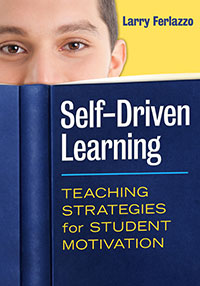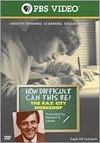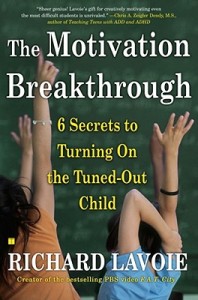Motivating All of Our Learners
A MiddleWeb Blog
Here’s a question that comes to my mind each day as I teach in my inclusion classes: How can we spark our students’ curiosity enough to encourage them to be active listeners, eager participators, and interested learners throughout the forty-one minutes of class time?
My focus as I strive to answer this question has two parts. The first part lies in the way we plan to teach the content. I ask, what strategies did we put in place to engage the students? The second part of my answer involves thinking about how we are going to help students to motivate themselves during the learning process?
The idea of helping students motivate themselves can become quite a heated topic among educators. In the many conversations I’ve had with colleagues over the years (both online and face to face), some feel that it’s up to the students to decide to take ownership for their learning. Others feel that the emphasis is on their teaching style and methods of delivery. They feel they need to be like an actor on stage as a way to entertain their students and (they hope) sustain their attention.
I say it’s some of both. We know that students’ attitudes toward learning play a crucial role in the results of learning. And we also know that our decisions about how to use class time — how we teach and engage — can either propel or shut down a positive learning attitude for so many students.
It’s All about Balance

Larry reminds teachers that we must look at the big picture — we must think about “why students would want to learn what we are teaching.” In addition, we must think about “how noncognitive character traits (self-control, perseverance, etc.) influence academic achievement and what we can do to help students develop them.”
Teaching in any classroom involves getting the students to buy in to the learning process. Larry’s book is now on my must-read-again, refer-back-to, share-with-colleagues shelf. It is a book that is valuable for all teachers, yet as a special education teacher, I find additional value for co-teachers.
In an inclusion classroom, there is an additional motivation curve ball to consider. In these classes we have students with special needs being educated alongside typical learners. The two teachers in the room must reconsider the instructional methods to make sure that additional supports are strong enough to meet the needs of all students.
The idea of motivation has a different spin to it in an inclusion classroom. It is no longer just about getting kids to buy into the learning. It is about taking into consideration the specific needs of students. There’s an added factor of how are we creating the ability for students to access the curriculum? How can we guide our students with disabilities to develop self-control and perseverance?

Often, students with learning disabilities misperceive information due to their specific learning disability. In inclusion classrooms, we must make sure to support learning needs, so that these students have the opportunity to become motivated to learn.
They need the access. And we are the gatekeepers for providing that access.
How to Motivate Students?
Larry Ferlazzo’s first chapter lays the groundwork for the rest of his book. He brings in the research to support that intrinsic motivation has long term positive effects to learning. The importance of having students set goals, make choices, and participate in cooperative learning all contribute to their ability to take ownership for their learning.
As I read through Larry’s book, I made many connections to the ideas shared by Lavoie in his book, The Motivation Breakthrough. Students with disabilities are often misunderstood as not being motivated when indeed they are completely motivated. They just aren’t motivated to do the things that teachers are asking them to do.

Do you know any students like this? These students are using their strategic thinking—just not in the ways we’d like. Lavoie states that a student in this situation is a kid who “didn’t have lack of motivation. He had a lack of success!” His motivational energy was driven by his need to avoid the task because he didn’t have any other strategy to help him to successfully complete the task.
Again, it falls on us. What access to the curriculum are we providing for these students to guide them to persevere and have the self-control to complete academic tasks in systematic ways? Check out this video where Lavoie describes the motivation process for students with learning disabilities in more detail.
Ferlazzo’s Strategies Can Guide Teachers
Larry Ferlazzo’s book offers many valuable strategies to guide teachers to help students feel more positive about the learning process. His ideas provide the answers about how to create an environment where students take on academic tasks in systematic ways rather than avoid them.
Larry identifies five action-oriented principles that teachers should weave into their daily instruction. Each action can help students to become intrinsically motivated and cognitively supported to become successful, independent learners.
- Building a classroom community of learners
- Activating students’ background knowledge
- Encouraging student leadership through cooperative learning
- Facilitating a classroom culture where students learn by doing
- Providing ongoing opportunities where students reflect on their learning
Larry’s book is filled with lesson plans that are so easy to adapt and personalize to one’s teaching situation. It is a book that I highly recommend for all teachers. Additionally, it should be a must read for all teachers in inclusion classrooms where we are faced with students who need additional tools to become self-directed learners. This is the book to provide those tools!


































Thanks for reviewing Ferlazzo’s book. Great ideas for practical applications. Your review came out at just the right time for me because I had partly composed a blogpost about the difference between “engaging” and “motivating”, and your description of Ferlazzo’s book was very useful. I’ve now ordered the book so I can read it myself!
As I state in my blog post, http://convergenceinthecommons.com/, I do think there is a difference between engaging and motivating, and people like Ferlazzo and Dan Pink give us great ideas that we can hopefully use in our classrooms.
Hi, Deborah. Thanks for sharing the link to your blog–I’m excited to check it out! It sounds like a perfect fit to our discussion here. I know what you mean; it’s always exciting to connect our ideas to the ideas of others. I think one main difference between engaging and motivating rests in helping students to take ownership for the process of learning. When they can connect to the learning personally, meaningfully, and actively, it creates a motivating and engaging experience that lasts beyond the moments of teaching. When the students take part in the learning that is motivating–it may only last for those moments.
What do you think?
Yes, Elizabeth; active learning certainly helps to increase motivation. Since this initial discussion I have had some further thoughts. Engagement is great, but it tends to be an outward expression of interest, and perhaps exists in the moment, as you allude to above. It can be described as the student being engaged in whatever is going on around them, or whatever activity the teacher provides. In contrast, I think that motivation is truly an inner drive (as Dan Pink might say), most often without any external assistance.
For instance, my 16-year-old son may be engaged in watching a movie of some sort for a while, whereas he is often motivated to watch a particular video because it will teach him something new about his hobby (mixing electronic music) that he will then work on for hours. One is in the moment; the other extends over time.
Yes, yes! There is such a fine line between engaging and motivating. And then, of course there’s the sub topics of extrinsic vs. intrinsic motivation. If extrinsic motivation is the source of learning–I think those are the for the moment kind of learning–and can be extended with the right balance of engagement and intrinsic variables.
I’ve seen students lose their true inner drive when the emphasis on learning was grades and other external motivating factors. Yet, I’ve seen those same students regain their momentum for learning when given the opportunities to make mistakes, learn from them, and build upon them…then thrive! The focus in these situations was on intrinsic motivation and engaging through a meaningful process of learning.
Thanks, it’s great to share thoughts with you!
I was curious if these books are geared towards a specific age group. I have found that most books talk about the elementary student and the same strategies don’t always work for middle school. Also, I am wondering if the strategies would also work for at risk students from extremely low income and low skills at the middle school level. Thanks for your post. It was motivating:)
Hi, Erin,
Yes, these books are geared toward any teacher, any grade, any situation. Richard Lavoie’s books and videos help teachers and parents to see the world through the eyes and emotions of the student. It is really a mind blowing experience in regards to raising awareness and sensitivity to sensing what kids go through and knowing and doing what they need.
Larry’s book is the perfect resource for the teacher who wants to build a community of life-long learners. Check out Larry’s website and be prepared to get really motivated! Here’s the link. Thanks for your post.
http://larryferlazzo.edublogs.org/2013/01/17/heres-the-table-of-contents-link-to-pre-order-my-upcoming-book/
Teacher’s behavior and teaching style, the structure of the course, the nature of the assignments and interactions with students all have a large effect on student motivation. Motivation does not only depend on teacher’s behavior and instruction, but also depends on students to motivate themselves; for example by writing personal goals, and remind themselves of what they want in life to succeed.
Yes, Sharifa–Thanks for adding your voice to the discussion! Check out this link, which is at Larry’s blog, which will definitely support and extend your thinking…
http://larryferlazzo.edublogs.org/2013/03/31/heres-a-goal-tracking-sheet-im-giving-to-students/
Enjoy!
Loved this post! The information really supports the engagement principle under Universal Design for Learning (UDL)! Thanks, Elizabeth!